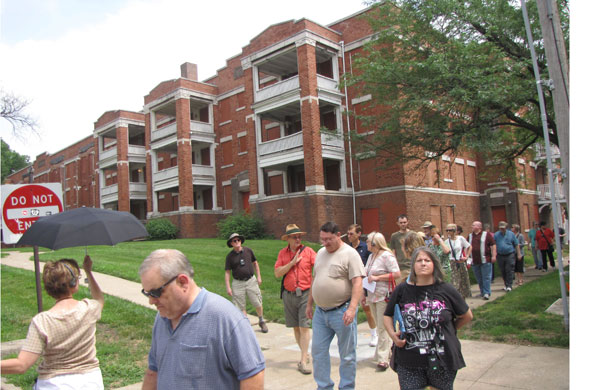
Bill Worley (in the orange shirt) led a tour of the historic Valentine neighborhood on Sunday. One stop was the Knickerbocker Apartments, currently listed by the Historic Kansas City Foundation as the 6th most endangered building in the city.
Why is Valentine Road so curvy? Why are houses in Midtown so close together?
Bill Worley, history instructor with Metropolitan Community Colleges, answered those questions and more on a Sunday walking tour of the Valentine Neighborhood.
The Kansas City Museum sponsored the tour, which is one of a series.
City Beautiful Movement advocates considered curved streets like those on Valentine Road elegant and J C Nichols would later spread the curves in developments farther south, Worley said.
Valentine Road, like Janssen Place road in Hyde Park, was named for a rich investor who never lived in Kansas City.
Midtown houses were generally built close together because owners were taxed based on the number of liner feet their lots had on the street.
Corner lots, taxed higher, were often more swank to make that worthwhile, Worley said.
His tour started in the parking lot of the Uptown Shoppes, which was once the lawn of the Bird family estate (as in the Emery Bird Thayer Department Store). The home was torn down in the 1930s to make way for commercial construction. An ornate gate on Pennsylvania Avenue still has the estate name chiseled in stone: Elmhurst.
What are now the Valentine, Roanoke and Coleman Highland neighborhoods were laid out as subdivisions on the city’s southern fringes during a real estate boom in the 1880s.
“But you know what happens to boom,” Worley said, “there’s a bust.”
Many of what were then lavish homes and apartments were built from 1900 to 1914, the start of World War I. Then many were built in the booming 1920s.
The walk started south down Washington Street. Lots were bigger there than on streets to the west and many homes larger and more lavish. Some apartment buildings there called three story walk-ins there are typical of the 1920s. More than three stories required an elevator.
Garages were not common in homes before World War I and part of Washington’s appeal was a streetcar line. But after World War II the large houses near busy Broadway got broken up into apartments more than homes even one block west.
Property naturally shifts to what real estate investors call highest and best use, Worley said, and to them “best use” means most profit.
The walk turned west on 38th Street, where Worley noted the shirtwaist homes with stone on the lower floors and another material above.
Common at the time, shirtwaist referred to a working womens’ clothing style of a blouse of one material and color and a skirt of another.
The walk turned north up Pennsylvania Avenue, another street named after a tycoon. It was the home state of Kersey Coates, who laid out Quality Hill on his own land in the 1860s.
The walk stopped at what is left of the historic but endangered Knickerbocker Apartments at 501-535 Knickerbocker Place.
The adjacent Kansas City Life Insurance Company owns them. It demolished half of the complex in 1982 to make room for company expansion, after winning a battle against the Valentine Neighborhood Association and the Landmarks Commission of Kansas City.
Worley said the company and neighborhood have had a “symbiotic relationship” since the powerful insurance firm went in there in the 1920s, with it sometime supporting neighborhood causes and sometimes not.
“It’s one of those things – it’s an ongoing conversation,” he said. “I’m not sure the folks who own Kansas City Life would admit it but it’s hard to imagine Kansas City Life with no Valentine neighborhood.”



Who’s talking